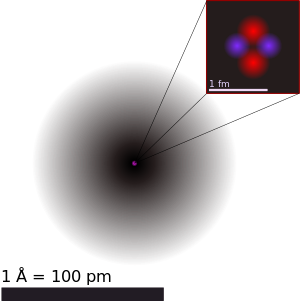Atom
From Wikipedia, the free encyclopedia
For other uses, see Atom (disambiguation).
| Helium atom | ||||||||
|---|---|---|---|---|---|---|---|---|
| An illustration of the helium atom, depicting the nucleus (pink) and the electron cloud distribution (black). The nucleus (upper right) in helium-4 is in reality spherically symmetric and closely resembles the electron cloud, although for more complicated nuclei this is not always the case. The black bar is one angstrom (10−10 m or 100 pm). | ||||||||
| Classification | ||||||||
| ||||||||
| Properties | ||||||||
|
An atom is the smallest constituent unit of ordinary matter that has the properties of a chemical element.[1] Every solid, liquid, gas, and plasma is composed of neutral or ionized atoms. Atoms are very small; typical sizes are around 100 pm (a ten-billionth of a meter, in the short scale).[2] However, atoms do not have well defined boundaries, and there are different ways to define their size which give different but close values.
Atoms are small enough that classical physics gives noticeably incorrect results. Through the development of physics, atomic models have incorporated quantum principles to better explain and predict the behavior.
Every atom is composed of a nucleus and one or more electrons bound to the nucleus. The nucleus is made of one or more protons and typically a similar number of neutrons (none in hydrogen-1). Protons and neutrons are called nucleons. Over 99.94% of the atom's mass is in the nucleus. The protons have a positive electric charge, the electrons have a negative electric charge, and the neutrons have no electric charge. If the number of protons and electrons are equal, that atom is electrically neutral. If an atom has more or fewer electrons than protons, then it has an overall negative or positive charge, respectively, and it is called an ion.
Electrons of an atom are attracted to the protons in an atomic nucleus by this electromagnetic force. The protons and neutrons in the nucleus are attracted to each other by a different force, the nuclear force, which is usually stronger than the electromagnetic force repelling the positively charged protons from one another. Under certain circumstances the repelling electromagnetic force becomes stronger than the nuclear force, and nucleons can be ejected from the nucleus, leaving behind a different element: nuclear decay resulting in nuclear transmutation.
The number of protons in the nucleus defines to what chemical element the atom belongs: for example, all copper atoms contain 29 protons. The number of neutrons defines the isotope of the element.[3] The number of electrons influences the magnetic properties of an atom. Atoms can attach to one or more other atoms by chemical bonds to form chemical compounds such as molecules. The ability of atoms to associate and dissociate is responsible for most of the physical changes observed in nature, and is the subject of the discipline of chemistry.
Contents
[hide]- 1History of atomic theory
- 1.1Atoms in philosophy
- 1.2First evidence-based theory
- 1.3Brownian motion
- 1.4Discovery of the electron
- 1.5Discovery of the nucleus
- 1.6Discovery of isotopes
- 1.7Bohr model
- 1.8Chemical bonding explained
- 1.9Further developments in quantum physics
- 1.10Discovery of the neutron
- 1.11Fission, high-energy physics and condensed matter
- 2Structure
- 3Properties
- 4Identification
- 5Origin and current state
- 6See also
- 7Notes
- 8References
- 9Sources
- 10Further reading
- 11External links




ليست هناك تعليقات:
إرسال تعليق